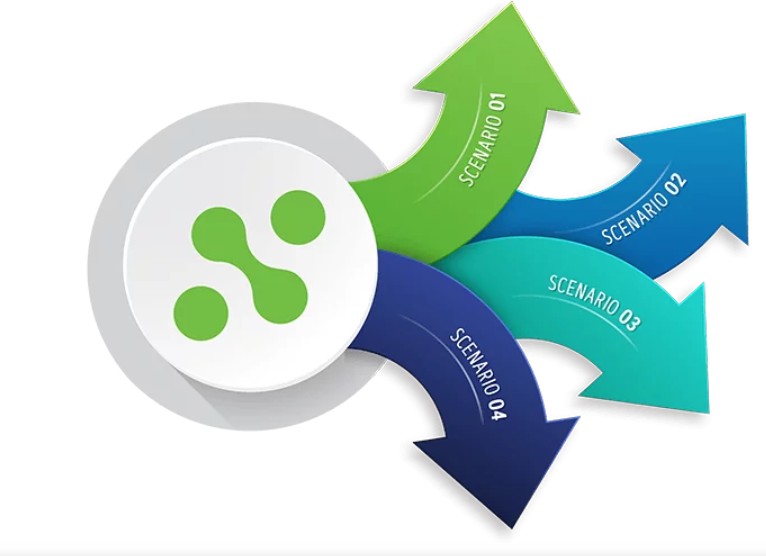Volatile change paralyzes individuals and organizations, creating marketplace fear, such as postponed purchases … canceled contracts… job losses.
Rather than be plagued by the unknown, individuals and organizations can take intentional steps to build resilience and confidence for the future by practicing the art of scenario planning.
Scenario-planning is a strategic planning method where organizations develop a number of possible futures based on key trends and uncertainties in a particular business setting, incorporating multiple perspectives, and then testing the viability of strategies in those worlds.
By assessing how strategies would perform in each scenario, individuals and organizations can anticipate potential challenges and opportunities, increasing preparedness for a wider range of outcomes and future opportunities.
Benefits for individuals and their organizations include agility, adaptability, and best of all – a growth mindset.
Scenario planning in six, easy steps
First, gather a diverse group of thinkers from your organization – various departments, experience levels, backgrounds, etc. (For individual scenario planning, you could do this alone or invite one or more friends to brainstorm with you.)
Second, define the issue, decision, question, or potential crisis to be discussed.
Third, identify the driving forces or big shifts in society such as economics, technology, social trends, and politics impacting that issue.
Fourth, list uncertainties having a big impact on your organization.
Fifth, identify four possible scenarios. Assign a descriptive name or “title” for each situation. Rather than try to predict the single, exact future that will occur, your group should consider a range of four plausible futures.
- Why four scenarios? Most planning consultants believe that with four scenarios, the exercise stays simple while also forcing the group to think beyond the standard three options that might otherwise be developed.
By considering four scenarios, from expected to wildly unpredicted, the shock factor is reduced. A strategic path forward can be developed for each scenario. It’s like writing a movie script with different endings – having a Plan A, B, C and D.
For example, your scenarios could include the EXPECTED case, BEST case, WORST case, and a highly unpredictable WILD CARD case.
An important reminder: The purpose of scenario planning is to plan for a number of possible futures, not to control the future, and not to select the one, right scenario!
As the sixth and final step, your team will:
- Describe the scenario and the circumstances leading to each scenario.
- Discuss the various implications and impacts of each scenario.
- Discuss the preparation and strategies needed to be ready for each situation.
- Discuss how your organization (or you at the individual level) should respond to each scenario.
- Summarize and present findings as needed for further decision making.
Large organizations may prefer to develop a series of scenario planning meetings spread out over several months. When sequenced as a series, topics such as trends, possible futures, and discovery activities can be staged in two- to three-hour time blocks to allow for shared learning and deep-dive discussions.
It’s important to note that complex scenario-planning may go beyond the capacity of a group conducting a simple brainstorm activity. Data-driven scenario-planning, such as predicting global unrest and economic modeling, may require experienced facilitators and analysts with skills needed for quantitative analysis and geopolitical intelligence, revealing underlying trends of significance, along with future implications of emerging world events.
Scenario planning terminology for aspiring futurists
Trend: Direction in which something is changing. Trend is a general tendency or direction evident from past events increasing or decreasing in strength of frequency of observation. It usually suggests a pattern.
Weak Signal: Early signs of currently small change. What is coming down the pike that could be a huge disruptor/surprise. Not an established trend yet. They often are “not necessarily important things” which do not seem to have a strong impact in the present, but which could be the trigger for major events in the future.
Wild Cards: High-impact events that seem too incredible, or are considered too unlikely, to happen; yet many do. They are warnings (external or internal) regarding events and developments that are still too incomplete to permit an accurate estimation of their impact and/or to determine their complete response. Wild cards may make your colleagues laugh! People may say it will never happen – only to discover years later that the wild card scenario became a reality.
Glossary source: https://antofagastaforesight.wordpress.com/methods/trends-megatrends-wild-cards-and-weak-signals/
Photo credit: Synario, at https://www.synario.com/solutions/scenario-planning/




